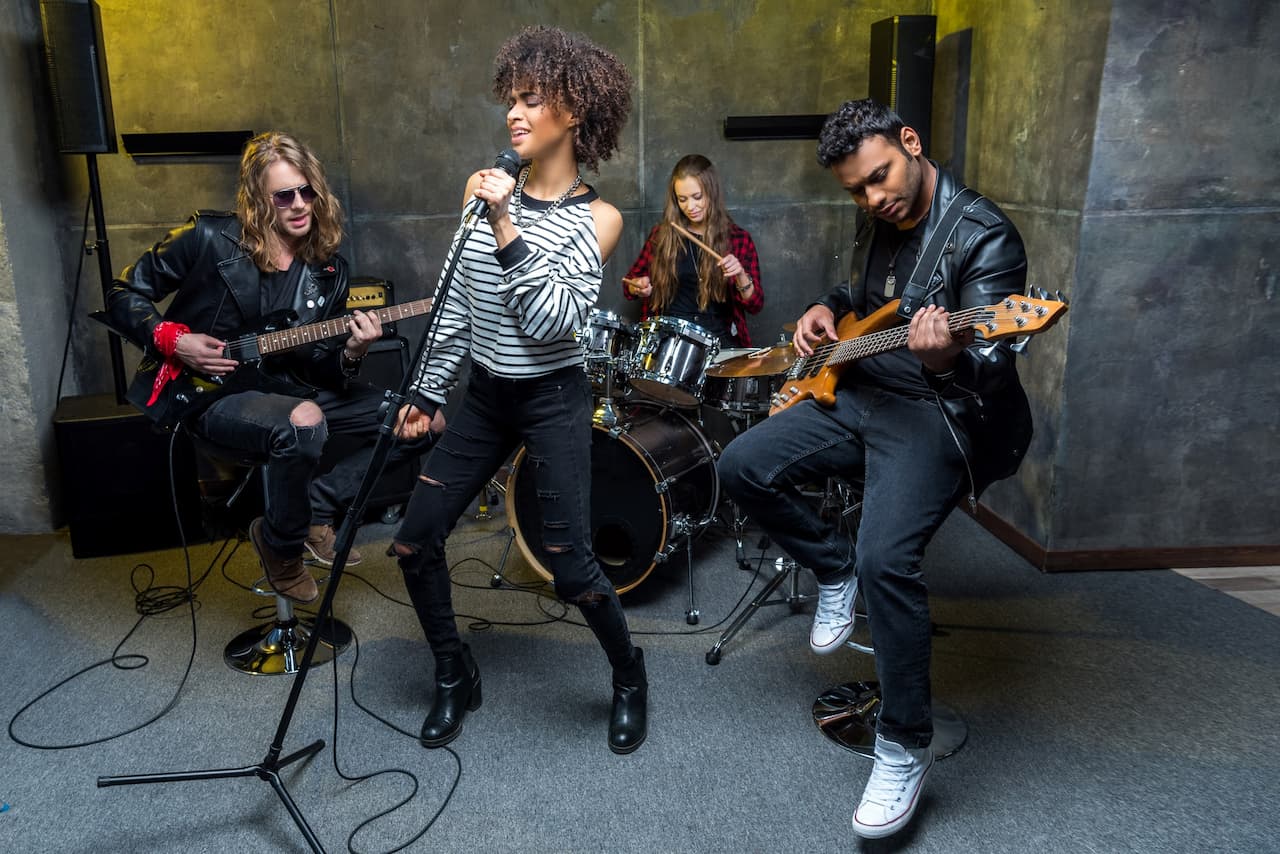Exploring the Role of Women in Rock Music
This blog post aims to explore the role of women within rock music, and address the barriers and stereotypes that exist across the genre. Rock music has often been a male-dominated industry, but times are changing and more female artists are making their voices heard as they challenge these conventions.
We will provide a historical context of how women have been represented in the rock industry over time, as well as consider how cultural norms, values and perspectives have created barriers to entry. We’ll also look at how stereotypes of female musicians have shifted in modern times, and the impact that influential female rock musicians have had on other genres like pop and hip-hop.
We will also discuss the emergence of male allies who are challenging traditional views and supporting greater diversity in rock music. Finally, we’ll consider current challenges facing the genre and how these can be addressed through action in order to further break down barriers and stereotypes.
By exploring these topics in detail, we hope to gain insight into the role of women in rock music, and the significant contributions they’ve made to the industry.
Historical Context: Women’s Representation in Rock Music
Women’s place in the rock music industry has a long, and often undiscussed, history. Before delving into the challenges they face today, it’s important to take a look at how women were represented in the past.
In the 1950s and 1960s, women in rock music were often portrayed as back-up singers with little to no solo music career. These singers were considered sidekicks to men, and the men dominated the spotlight by singing the lead vocals. This was especially true in genres such as rockabilly and doo-wop.
Women who attempted to take the lead in rock bands often faced criticism from male peers and audiences, who saw them as outside of the genre’s mainstream. Women also had more limited access to recording studios and resources, making it difficult for them to make music on their own terms. The lack of recognition and availability of resources curtailed an independent career for many female musicians of the time.
Things began to change in the late 1960s and early 1970s with the introduction of new styles of music, such as punk and heavy metal. For the first time, women were seen as equals in the industry, with groups like The Runaways and Suzi Quatro leading the charge. Their presence also ushered in a new era of female-led groups such as The Slits and Siouxsie and the Banshees.
These breakthroughs were met with mixed reaction; some cheering them on, while others disagreed that this could be a legitimate new style of music. Despite this, the presence of female musicians in the scene encouraged a generation of young women to pick up guitars, drums and microphones, showing them that there was a place for them in the industry if they wanted it.
Defining Rock Genres
Rock music is made up of many different genres and subgenres, each of which has its own distinct style of music. Understanding the different characteristics of each genre is a great way to appreciate the complexity and richness of rock music.
The traditional rock genres in the 1950s and 1960s are usually classified into six main categories: Rock and Roll, Blues, Jazz, Pop, Country, and Folk. This includes classic rock, blues-rock, folk-rock and country rock. These genres typically involve vocals, guitars, drums, and bass. They also include elements of improvisation, as well as melodies and harmonies.
In contrast, modern rock genres have evolved over time and can be classified as either alternative rock, indie rock, punk rock, grunge, metal, progressive rock and rap rock. These genres typically feature louder and heavier instruments, distortion and extreme tempos, and often draw on influences from other genres, such as jazz and classical music.
Within each genre, there are numerous subgenres, which add even further complexity. For example, if we look at the genre of Indie Rock, we can further divide it into Britpop, Shoegaze, Post-rock, Math Rock and Dream Pop.
When discussing the different characteristics of various rock genres, an important factor to consider is the instrumentation. Most traditional and modern genres use the same core instruments: guitar, bass, drums and vocals. However, some genres will feature additional instruments such as keyboards, horns or strings.
Another major factor to bear in mind is the lyrical content. In general, lyrics in traditional rock genres are usually more straightforward and consist of love and relationship themes. Modern rock, however, often explores more complex themes such as politics, culture and social issues.
Cultural Barriers for Female Musicians in Rock
The rock music industry has long been dominated by men, creating a challenging environment for female musicians to be successful. While there have been some women who have broken through the barriers and achieved success, many more are either unable to break into the industry or face overwhelming obstacles to do so.
Cultural perceptions of gender and music have been instrumental in creating these barriers. Traditionally, rock music is seen as being predominantly male, with lyrics focused around themes such as sex and drugs that can alienate female audiences. Furthermore, male-dominated lineups on festival bills and awards shows also send a strong message about the expected presence of women in the genre.
In addition, female musicians are often typecast into specific roles, with expectations that they will provide background vocals or play an instrument while a male frontman takes the lead. There is a perception that women don’t belong centre stage and that they lack the technical ability to be successful musicians in the genre of their choice.
These cultural barriers are hard to overcome and are likely holding back female musicians from achieving the same level of success as their male counterparts. Fortunately, there are encouraging signs that this is beginning to shift, as more female musicians are starting to carve out careers in rock music.
It is still essential that we address the barriers and stereotypes, in order to create an environment where women feel confident and supported to be successful. This will not only benefit those who are currently in the industry, but those coming through who can see a brighter future for female rockers.
Historical Stereotypes of Women in Rock Music
The history of rock music is defined by a variety of stereotypes regarding female musicians. In the past, women were often seen as unimportant or even invisible when it came to rock music, with many traditional rock bands mostly consisting of male members and excluding female talent.
Women who did manage to break through the barrier often faced negative and degrading stereotypes. For example, they were viewed as being unable to play an instrument, too emotional or lacking technical skill, or not serious enough to be taken seriously in the genre. This caused many women to feel discouraged and disrespected in the music world, a problem which has sadly continued into the modern era.
These stereotypes have drastically shaped female representation in the industry, slowly pushing women out of the spotlight and diminishing their success. It has also resulted in a lack of female representation in popular rock songs, as most were recorded and produced by men.
However, as society has become more open-minded and progressive in its views, the role of women in rock music has begun to shift. Women are now more accepted and celebrated for their unique sounds and talents, and there is a rapidly growing number of girls and women taking up instruments and playing in bands.
With the emergence of female-fronted bands, more representation of strong female musicians in popular music, and the growth of female fanbases in the industry, we are finally seeing a positive shift in the way female musicians are perceived today.
Women have been pushing back against the stereotypes and making their voices heard, proving that they can deliver powerful and inspiring performances just like any male musician. We can see this trend continuing, as more and more female musicians are given the recognition and respect they deserve for their contribution to rock music.
Modern Era: Shifting the Narrative
In recent years, female musicians have made a presence in the rock genre, creating a greater level of diversity within the industry. This has come about through a variety of factors, from changing attitudes to supportive initiatives created by record labels. As a result, female musicians have been able to use their platform to break down barriers and stereotypes that have previously held them back.
Women have become increasingly visible in rock music, appearing on radio and streaming services, in line-ups at major festivals, and on album covers. This is partly due to record labels and industry professionals actively taking steps to improve gender equality within the industry. Examples include initiatives such as the PRS Foundation’s Keychange programme, which works to equalise the gender ratio of festival line-ups and encourage female representation in the music industry. There are now more initiatives than ever aimed at supporting and amplifying women in the music industry.
It has also become much easier for female musicians to reach out to and engage with fans via social media platforms, enabling them to directly connect with potential listeners and share their story. Many developing female rock stars have used this platform to challenge the traditional narrative, promoting messages of acceptance, solidarity and empowerment as well as demonstrating their own talent.
Thanks to the hard work of female musicians, there has been a gradual shift in representation in the industry. Whilst there is still progress yet to be made, it is becoming increasingly common to see female-led bands performing in mainstream venues and producing chart-topping records.
Artists as Trailblazers: Celebrating Female Musicians in Rock Music
Women have always been part of the fabric of rock music, but they were often pushed to the side as male artists took center stage. In recent years, female artists have become major forces in the industry and are using their influence to challenge traditional gender stereotypes. In this section, we will take a look at some of the influential female rock musicians and how they are challenging stereotypes and serving as trailblazers.
We can begin by looking at some of the biggest names in the rock genre, such as Joan Jett, who rose to fame in the 1970s. Despite being a strong female presence in a male-dominated genre, she faced plenty of criticism from the media and her peers. Nevertheless, she kept going and her influence was momentous, paving the way for other female artists who followed her.
In recent years, there have been many other trailblazing female rock musicians contributing to the genre. Think of artists like Taylor Momsen and Courtney Love, who embrace their femininity and use it to their advantage. They challenge the traditional view that rock music is a male-dominated genre, proving that women can be just as talented and influential.
More modern rock artists such as Halsey and Hayley Williams are also using their platform to challenge gender norms. Halsey is an outspoken advocate for equality and Hayley Williams has used her music and lyrics to challenge society’s expectations of what it means to be a young female artist in the rock genre.
These artists are inspiring a generation of young female musicians and changing the narrative around women in the rock genre. By defying stereotypes and embracing their femininity, they are helping to create a more inclusive and diverse industry.
It’s clear that female artists are playing an increasingly important role in the rock music genre today. From Joan Jett to Halsey, these female rock trailblazers are challenging stereotypes and proving that women can contribute just as much to the genre as men.
Music Impact
The impact of female representation in rock music has been felt in other genres such as pop and hip-hop. This is because many female artists in rock have used their platform to promote greater equality and diversity, inspiring a more inclusive music industry for everyone.
Female representation in rock has allowed for greater levels of creativity and experimentation with different sounds and styles. This has transcended into other genres and created an environment where female artists can express themselves to a larger audience without fear of judgement or stagnation.
For example, women in the rap and hip-hop scenes are now being celebrated as trailblazers and allowed to explore their individual sounds and styles with confidence. The new wave of female rock artists has also empowered a new generation of pop artists to be bolder in their music, making them even more successful.
We are now seeing music that speaks to a wider range of experiences and addresses topics that are relevant to all genders, races, and ages. As a result, music has become more accessible and relatable to a wider audience, creating a more diverse and vibrant music industry.
Therefore, it is clear that female representation in rock has had a powerful effect on other genres. With more courageous and vocal female artists lending their voices to the industry, music is becoming a more inclusive and expressive experience for all.
Male Allies: Challenging Traditional Rock Music Views
In the rock music world, men have traditionally been at the forefront. While there have been some female musicians that have made their mark in the industry, they have usually had to fight against cultural barriers and stereotypes. This is why it is so important to recognize the male allies that are now emerging to challenge these traditional views and support greater diversity in the rock genre.
These male allies are standing up for female musicians and encouraging more women to make their way into the field. They are challenging outdated stereotypes that have been around for centuries, and celebrating the unique contributions that female artists can make. Male allies are often prominent members of the industry themselves, such as band members, producers, managers, promoters and other influential figures.
Their support is invaluable for giving a platform for female musicians to showcase their music and further break down the barriers and stereotypes within the rock music industry. With the help of male allies, female artists are able to gain more recognition and acknowledgement in the field, while being able to express themselves and their creative talents.
It is important to note that male allies are not just focusing on female musicians. They are striving to create a more inclusive rock music industry as a whole, allowing all genders and backgrounds to be represented. This also means they’re calling attention to issues like racism, homophobia, and other forms of discrimination that have been pervasive in the music scene for far too long.
As male allies become more visible in the rock music landscape, we are witnessing a shift towards greater diversity and representation. We can only hope that this kind of progress continues, and that more men will step up and challenge traditional views in order to create a more accepting industry for all.
Challenges Ahead: Exploring Current Issues Facing Rock Music
The rock music genre has been historically underrepresented in terms of female musicians, but there are signs of progress in more recent times. However, the progress made is not enough, with many challenges still facing women in rock today.
Whilst some artists are successful in using their platform to shift the narrative of traditional stereotypes and challenge cultural barriers, these are often still present in rock music. Issues such as sexual objectification and representation of female roles continue to be visible, as do issues around limited access to resources and opportunities for female musicians.
The lack of female performers in festivals and concert line-ups is an ongoing issue, with only an estimated 14% of festival headliners in 2019 being female. This further contributes to the lack of visibility of women within the rock genre, making it harder for them to be heard and succeed. These issues are further exacerbated by poor financial rewards, with women musicians reportedly earning up to 28% less than male colleagues.
Gender inequality in the industry is also perpetuated through wider media representation, with females often being portrayed as sidekicks rather than main characters. This can lead to female musicians not being taken seriously and having difficulty developing a following or fan base.
To address these issues, greater representation in all aspects of music production and promotion is needed. Companies should also look to enable equal pay for work done and invest in initiatives that support female led bands. This would help create more visibility of female musicians and role models for aspiring female rock stars. Ultimately, more collaboration between male and female musicians is needed to ensure that rock music can become more inclusive for everyone.
Conclusion
In exploring the role of women in rock music and in breaking down barriers and stereotypes, we’ve examined the changing landscape of female representation in the industry. From its historical context, to the various genres and cultural barriers, to the shift in stereotypes, we have looked at how far female musicians have come but also what challenges still need to be addressed.
We looked at influential female musicians and the impact their presence is having on the music industry as a whole, male allies who are supporting greater diversity in rock music and the challenges that remain. It’s clear that there is more yet to be done to foster an inclusive and equitable environment for female musicians.
Ultimately, rock music has not only celebrated the talent of female musicians but encouraged them to push boundaries and challenge traditional views. This progress should continue to be promoted and fought for in the years to come, and everyone can play a part in achieving this goal.


